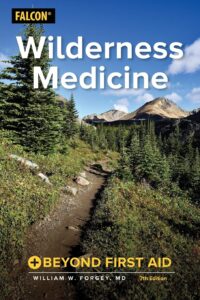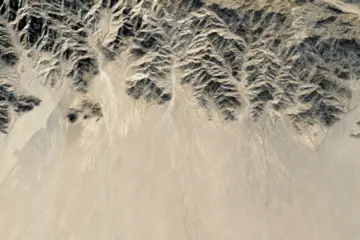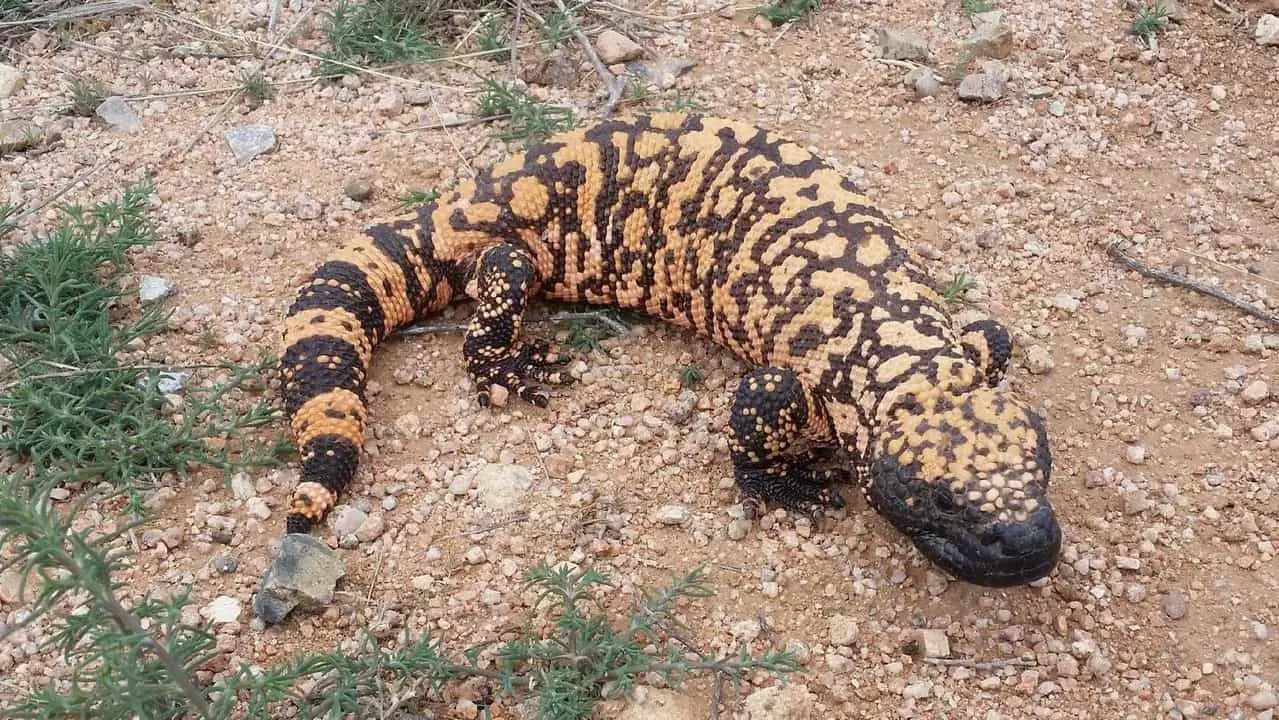Inventor of the First Aid Kit
Robert Wood Johnson co-founder of Johnson & Johnson developed and released the first aid kit in 1888 to treat railroad construction workers, who, when injured, were often many miles from treatment. Soon after that, the first aid kit became available to the public.
Individual First Aid Kit (IFAK) for desert exploring
What size first aid kit should you get?
A first aid kit with some specialized additions, tailored to remote desert exploration situations will be discussed here. First aid supplies are an important addition to any exploration or camping setup.
If you travel in an RV for extended periods, you might want a fairly extensive kit. If you are more the weekend warrior, you might want a smaller kit for your truck or side by side. If you do a lot of remote exploring or prospecting on foot, a small kit with some additions may be what you should carry.
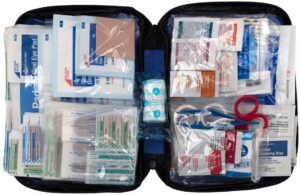
Individual First Aid Kit (IFAK)
Let’s start with the smaller setup. First off, what are the most likely accidents to happen when traversing rugged country on foot?
- Ankle, knee or leg injuries from mis-steps or falls.
- Lacerations and/or broken bones from serious falls or rock fall
- Rattlesnake or other venomous bites or stings
- Shock from the above
- General smaller cuts, abrasions and blisters
- Hypothermia or hyperthermia
Ankle, knee or leg injuries, soft tissue damage and broken bones
Probably the most common injuries for the cross country explorer. You need to use common sense after an injury of this sort. You don’t want to cause more damage by trying to walk out. Then again, do you need to hit the panic button on your PLB? Injury assessment, pain threshold and common sense should be the deciding factors.
If, after assessment, you suspect internal injury, serious head or spinal injury, then of course you should not hesitate to signal for rescue. But this is a post on first aid kits not first aid treatment.
If you would like to learn more about first aid treatment, wilderness first aid and/or certificate courses, check out some of the links at the end of this post.
SAM splint
Definitely consider carrying a SAM splint. Created by Vietnam war trauma surgeon Sam Scheinberg, it can be used in any situation that requires an extremity to be supported or immobilized. Small, lightweight and moldable, it would make an excellent first aid addition. If you get the 36” roll you can cut it down to the size needed.
The splint, properly applied, could mean the difference between making it back to your vehicle or calling for search and rescue. Don’t forget some lengths of duct tape or other strapping material to securely fasten in place. Get two, and practice with one to find the most effective splinting positions. Weight: 4 oz.
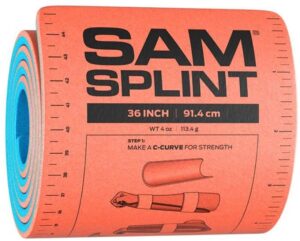
Israeli bandage
The Israeli bandage was invented by Bernard Bar-Nalan, an Israeli military medic. Used by NATO in Bosnia, and by US forces in Iraq, it’s become standard issue in many first aid kits.
Designed to help staunch blood flow from traumatic wounds, it’s small, lightweight and can save lives.
Consider adding one to your IFAK. Hopefully you will never need it, if you do, you will be glad you carried it with you. Weight: 2.9 oz.
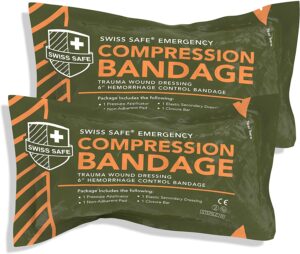
Emergency thermal blanket
An emergency thermal blanket is another good addition to your IFAK. Made of mylar with a foil reflective surface designed to keep up to 90% of body heat from escaping. The mylar emergency blanket can be a lifesaver in situations where hypothermia or shock are involved.
Not to mention making you a bit more comfortable if you have to spend an unexpected night out in the wild. Weight 2 oz.
Snake bite kit or venom extractor
Traditional snake bite kits have gotten somewhat of a bad name in recent years. Mainly I believe, because they are misused, and because people tend to panic after being bitten. Instead of using the included scalpel to make a tiny incision at each fang puncture, they make large ones and end up doing more harm than good. Also as you probably know, misuse of a tourniquet can cause all sorts of serious problems.
I carry a snakebite kit and have for years. The Red Cross and most wilderness first aid schools don’t recommend them. The most common reason seems to be this: They ask if you are able to remove the serum from a flu vaccination with a suction extractor? That’s a poor analogy at best and I’ll tell you why.
A vaccination is intentionally administered deep into a large muscle mass. The location of most snake bites are on the ankle or the hand, areas of low muscle mass. If the bite is in the calf or another large muscle, then no, a snakebite kit will not work.
I once saw someone bitten on the back of the hand by a rattler, and I could actually see the venom seeping from the bite. Luckily he was not too far from medical attention.
To be effective a snakebite kit needs to be used quickly. Suction should be applied within one minute and no more than three. The entire extraction process should take no more than 15 minutes, including the use of tourniquet or constrictor.
I’ve prospected and explored rattlesnake country for years and I’ve had many encounters with rattlers and sidewinders, some close, some not. Never been bitten. But if I am, I would like to try and reduce the venom load in my system, even a little, before attempting a possible hours-long journey back to my vehicle. Every situation is different.
Snake gaiters or leggings might be considered if you travel through rattlesnake country often.
See my post: Venomous desert dwellers
Other first aid items to round out your IFAK
(➤= Amazon link)
- Nitrile gloves (2 pair) ➤
- Triangular bandage (1) used for bandage, sling or tourniquet. 40x40x56” ➤
- Compress dressing (2) 5×9” ➤
- Adhesive bandages (assorted sizes) Fabric type seems to stay stuck longer ➤
- Gauze roll (2) 3” ➤
- Elastic bandage (1) 4” roller ➤
- Gauze pad (4) 3×3” ➤
- Gauze pad (4) 4×4” ➤
- Adhesive cloth tape (1) 1”x30’ ➤
- Instant cold pack (1) ➤
- Hydrocortisone ointment (2) 0.9g packets ➤
- Antibiotic ointment (4) 0.5g packets ➤
- Ibuprofen and or acetaminophen (10 or 15 of each) ➤
- Antihistamine (10 or so) diphenhydramine (Benadryl) ➤
- Antiseptic wipes (6 or 8) small ➤
- Trauma shears (4” small) ➤
- Moleskin (3) 3” square or similar ➤
The item list above is what I carry in the field. When you buy the items individually, you’re going to have more than needed for one first aid kit. Consider making more than one kit. One for the RV and maybe one for your vehicle, etc.
Now that we’ve itemized a lot of potential additions to your IFAK, you should have a good pouch or module to put everything in, and have quick access to it at all times.
Here are a few more items worth mentioning, I have no experience with the following, but they are highly rated, and worth more research.
First Aid reference guides and books
Canadian Red Cross First Aid pocket guide (free download)
Basic information and a good place to start
American Red Cross Adult first aid/CPR/AED ready reference $(3.95)
Used in Red Cross training courses. A good reference guide
A highly rated first aid book for remote areas
Wilderness Medicine: beyond first aid
